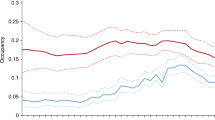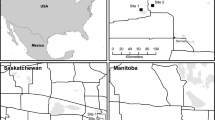Abstract
Animals are assumed to play a key role in ecosystem functioning through their effects on seed set, seed consumption, seed dispersal, and maintenance of plant communities. However, there are no studies investigating the consequences of animal scarcity on seed set, seed consumption and seed dispersal at large geographical scales. We exploited the unprecedented scarcity of pollinating bumblebees and butterflies in the vicinity of Chernobyl, Ukraine, linked to the effects of radiation on pollinator abundance, to test for effects of pollinator abundance on the ecosystem. There were considerably fewer pollinating insects in areas with high levels of radiation. Fruit trees and bushes (apple Malus domestica, pear Pyrus communis, rowan Sorbus aucuparia, wild rose Rosa rugosa, twistingwood Viburnum lantana, and European cranberry bush Viburnum opulus) that are all pollinated by insects produced fewer fruit in highly radioactively contaminated areas, partly linked to the local reduction in abundance of pollinators. This was the case even when controlling for the fact that fruit trees were generally smaller in more contaminated areas. Fruit-eating birds like thrushes and warblers that are known seed dispersers were less numerous in areas with lower fruit abundance, even after controlling for the effects of radiation, providing a direct link between radiation, pollinator abundance, fruit abundance and abundance of frugivores. Given that the Chernobyl disaster happened 25 years ago, one would predict reduced local recruitment of fruit trees if fruit set has been persistently depressed during that period; indeed, local recruitment was negatively related to the level of radiation and positively to the local level of fruit set. The patterns at the level of trees were replicated at the level of villages across the study site. This study provides the first large-scale study of the effects of a suppressed pollinator community on ecosystem functioning.





Similar content being viewed by others
References
Ashman TL, Knight TM, Steets JA, Amarasekare P, Burd M, Campbell DR, Dudash MR, Johnston MP, Mazer SJ, Mitchell RK, Morgan MT, Wilson WG (2004) Pollen limitation of plant reproduction: ecological and evolutionary causes and consequences. Ecology 85:2408–2421
Bibby CJ, Hill DA, Burgess ND, Mustoe A (2005) Bird census techniques. Academic, London
Bunzl K, Kracke W, Vorwohl G (1988) Transfer of Chernobyl-derived 134Cs, 137Cs, 131I and 103Ru from flowers to honey and pollen. J Environ Radioact 6:261–269
Burd M (1994) Bateman’s principle and plant reproduction: the role of pollen limitation in fruit and seed set. Bot Rev 60:83–139
Cohen J (1988) Statistical power analysis for the behavioral sciences, 2nd edn. Lawrence Erlbaum, Hillsdale
Costanza R, d’Arge R, de Groot R, Farber S, Grasso M, Hannon B, Limburg K, Naeem S, O’Neill RV, Paruelo J, Raskin RG, Sutton P, van den Belt M (1997) The value of the world’s ecosystem services and natural capital. Nature 387:253–260
Cramp S, Perrins CM (eds) (1988–1994) The birds of the Western Palearctic, vols 1–9. Oxford University Press, Oxford
Crawley JM (2002) Statistical computing. An introduction to data analysis using S-plus. Wiley, Chichester
European Union (1998) Atlas of Caesium deposition on Europe after the Chernobyl accident. EU Publication EUR 16733, Bruxelles
Faegri K, van der Pijl L (1966) The principles of pollination ecology. Pergamon, Oxford
Hooper DU, Chapin FA III, Ewel JJ, Hector A, Inchausti P, Lavorel S, Lawton JH, Lodge DM, Loreau M, Naeem S, Schmid B, Setälä H, Symstad AJ, Vandermeer J, Wardle DA (2005) Effects of biodiversity on ecosystem functioning: a consensus of current knowledge. Ecol Monogr 75:3–35
Kearns CA, Inouye DW, Waser NM (1998) Endangered mutualisms: the conservation of plant–pollinator interactions. Annu Rev Ecol Syst 29:83–112
Kevan PG (1999) Pollinators as bioindicators of the state of environment: species, activity and diversity. Agric Ecosyst Environ 74:373–393
Knight TM, Steets JA, Vamosi JC, Mazer SJ, Burd M, Campbell DR, Dudash MR, Johnston MO, Mitchell RJ, Ashman T-L (2005) Pollen limitation of plant reproduction: pattern and process. Annu Rev Ecol Syst 36:467–497
Kordium EL, Sidorenko PG (1997) The results of the cytogenetic monitoring of the species of angiosperm plants growing in the area of the radionuclide contamination after the accident at the Chernobyl Atomic Electric Power Station. Tsitol Genet 31:39–46
Loreau M, Naeem S, Inchausti P (eds) (2002) Biodiversity and ecosystem functioning. Oxford University Press, Oxford
McGregor SE (1976) Insect pollination of cultivated crop plants. USDA, Tucson
Møller AP (1983) Methods for monitoring bird populations in the Nordic countries. Nordic Council of Ministers, Oslo
Møller AP, Jennions MD (2002) How much variance can be explained by ecologists and evolutionary biologists? Oecologia 132:492–500
Møller AP, Mousseau TA (2006) Biological consequences of Chernobyl: 20 years after the disaster. Trends Ecol Evol 21:200–207
Møller AP, Mousseau TA (2007a) Species richness and abundance of birds in relation to radiation at Chernobyl. Biol Lett 3:483–486
Møller AP, Mousseau TA (2007b) Determinants of interspecific variation in population declines of birds from exposure to radiation at Chernobyl. J Appl Ecol 44:909–919
Møller AP, Mousseau TA (2009) Abundance of insects and spiders in relation to radiation at Chernobyl. Biol Lett 5:356–359
Møller AP, Mousseau TA (2011) Efficiency of bio-indicators for low-level radiation under field conditions. Ecol Indicat 11:424–430
Mouton M (2011) Significance of direct and indirect pollination ecosystem services to the apple industry in the Western Cape of South Africa. PhD thesis, University of Stellenbosch
Nicoll MF, Chapman GP, James DJ (1987) Endosperm responses to irradiated pollen in apples. Theor Appl Genet 74:508–515
Price MV, Campbell DR, Waser NM, Brody AK (2008) Bridging the generation gap in plants: pollination, parental fecundity, and offspring demography. Ecology 89:1596–1604
Proctor M (1996) The natural history of pollination. Timber, Portland
SAS Institute Inc (2012) JMP version 10. SAS Institute, Cary
Shestopalov VM (1996) Atlas of Chernobyl exclusion zone. Ukrainian Academy of Science, Kiev
Stern RA, Goldway M, Zisovichi AH, Shafir S, Dag A (2004) Sequential introduction of honeybee colonies increases crosspollination, fruit-set and yield of ‘Spadona’ pear (Pyrus communis L.). J Horticult Sci Biotechnol 79:562–658
Waser NM, Campbell DR, Price MV, Brody AK (2010) Density-dependent demographic responses of a semelparous plant to natural variation in seed rain. Oikos 119:1929–1935
Yablokov AV, Nesterenko VB, Nesterenko AV (2009) Chernobyl: consequences of the catastrophe for people and nature. New York Academy of Sciences, New York
Zakharov VM, Krysanov EYu (eds) (1996) Consequences of the Chernobyl catastrophe: Environmental health. Center for Russian Environmental Policy, Moscow
Acknowledgments
We gratefully acknowledge logistic support and help in Ukraine by I. Chizhevsky, G. Milinevski, G. Rudolfsen, S. Rushkovsky, and N. Saino. N. Waser and three anonymous reviewers provided constructive comments. We gratefully acknowledge support from the US National Science Foundation, the University of South Carolina Environmental Research Initiative Committee (ERIC), the University of South Carolina School of the Environment, the NATO CLG program, the CRDF, the Fulbright Program, the National Geographic Society, and the Samuel Freeman Charitable Trust. The research was conducted with all required permissions in Ukraine.
Author information
Authors and Affiliations
Corresponding author
Additional information
Communicated by Jeff Karron.
Rights and permissions
About this article
Cite this article
Møller, A.P., Barnier, F. & Mousseau, T.A. Ecosystems effects 25 years after Chernobyl: pollinators, fruit set and recruitment. Oecologia 170, 1155–1165 (2012). https://doi.org/10.1007/s00442-012-2374-0
Received:
Accepted:
Published:
Issue Date:
DOI: https://doi.org/10.1007/s00442-012-2374-0




